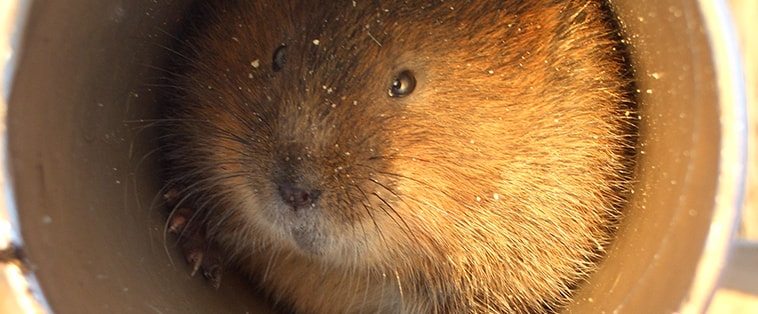Southern Ecological Solutions (SES) has a proven track record delivering projects where water vole and ecological surveys are required. Pride and diligence is taken to meet client’s ecological obligations and commercial needs in a cost effective and pragmatic way.
SES has experience and skills to carry out mitigation works such as habitat creation through the design and excavation of new waterways including the translocation of vegetation or planting of new water vole specific vegetation. SES in-house teams also have installed various specification of exclusion fencing.
Ecology
Water Voles are the largest of Britain’s vole species weighing up to 350g and measuring around 35cm. The Water Vole is often confused with the Brown rat Rattus norvegicus but can be easily distinguished by their short hair-covered tail, blunt rounded nose, rounded face, small ears almost completely hidden by fur and a rich chestnut-brown coat. Water Voles can live for up to 2 years in the wild.
Water voles can occupy various water bodies such as rivers, streams, ditches, lakes and ponds. A Water voles optimum habitat however would consist of a slow moving water body that maintains a consistent level of water. Bank side features should include continuous semi emergent vegetation; the banks themselves should ideally be stepped and slope at around 45 degrees and consist of earth that allows The Water vole to burrow into; these burrows can reach 5m back from the water’s edge and have numerous horizontal levels to act as insurance against flooding; each burrow has a number of entrances above and below the water level to escape from predators; their burrows will also contain food storage chambers and nesting chambers.
Water voles tend to avoid areas that are heavily over shaded, trampled or heavily grazed. Water voles are herbivorous feeding on bank side vegetation typically herbs, sedges, reeds and grasses. They are messy eaters and feeding signs can be seen on vegetation in the form of 45 degree ‘cuts’ which are left in feeding ‘stations’ or randomly across the bank side.
Water voles live in colonies but string themselves out along a waterway. Breeding female water voles are territorial and it is the female territory which represents the breeding unit. Males are not territorial as such and have ranges that overlap with the ranges of many females and other males. Males however do compete for access to females. Depending on habitat quality and population density males tend to have home ranges of around 60m to 300m and females have territories 30m to 150m. Ranges are marked with latrines (piles of droppings that have been padded down) that can be found along water vole ‘runs’ at the water’s edge, next to nests and at range boundaries.
Water voles have many predators including brown rats, Grey heron (Ardea cinerea), Otter (Lutra lutra) but most significantly the non-native American mink (Mustela vision). The American mink is a serious threat to Water vole populations in some cases completely wiping out entire colonies. The major problems being that American mink are expert swimmers and more importantly can fit through borrow entrances therefore the Water voles natural predator evasion techniques are useless. Along with the American mink problem habitat loss, degradation and fragmentation are responsible for the severe population declines suffered by Water Voles which have lost 95% of their population range. The major causes are thought to be un- sympathetic agricultural management techniques e.g. heavy grazing.
Legal Status and Planning Policy Protection
Due to the major declines Water Voles receive legislative protection which was further strengthened from April 2008. Water Voles are protected under section 9 of the Wildlife and Countryside Act 1981 (as amended), it a criminal offence to:
- intentionally or recklessly damage, destroy or obstruct access to any structure or place used for shelter or protection;
- intentionally or recklessly disturb Water Voles whilst occupying a structure or place used for that purpose;
- intentionally kill, injure or take Water Voles;
- posses or control live or dead Water Voles or derivatives;
- sell Water Voles or offer or expose for sale or transport for sale;
- publish or cause to be published any advertisement which conveys the buying or selling of Water Voles.
The maximum fine per offence is £5000 the Countryside and Rights of Way Act 2000 amendment contains a provision for a custodial sentence of up to 6 months instead of, or in addition to, a fine. Along with a lengthy development delay until an appropriate mitigation programme has been agreed and completed.
The Natural Environment and Rural Communities Act 2006 (NERC) also lists water vole as a species of principle importance under Section 41 and Section 40 requires every public body in the exercising of its functions (in relation Section 41 species) ‘have regard, so far as is consistent with the proper exercise of those functions, to the purpose of conserving biodiversity’. In addition, local authority planning departments should also meet the requirements of chapter 11: Conserving and enhancing the natural environment, of the Nation Planning Policy Framework (2012); which requires planners to not only protect biodiversity, but where possible to enhance. Obligations under planning policy represent a ‘material consideration’ to the local planning authority with ecological survey being required before planning permission can be granted.
Survey
Although water vole surveys can be undertaken at any time during the year, the breeding season (mid-April to mid-September) is when Water voles are most active above ground and therefore field signs are most abundant. Outside these periods field signs are less abundant as water voles spend most of the time below ground with field signs being susceptible to heavy rain and fluctuating water levels. Because of the fragility of field signs, absence at any time of year should be viewed with caution. Field signs include latrines, droppings, cutting patterns on vegetation (45 degree angle), burrow systems and ball nests.
Mitigation
SES has experience delivering mitigation schemes using techniques including passive persuasion where animals are encouraged to move to nearby alternative habitats this may also include exclusion fencing. SES has also translocated animals from donor to receptor habitats.



